#miriam fairfax
Text

Miriam Fairfax
#Miriam Fairfax#pinup#vintage cheesecake#50’s pinup#vintage smut#60’s pinup#mid century pinup#vintage sleaze
2K notes
·
View notes
Text

Miriam Fairfax
Thanks @hatefulelina
468 notes
·
View notes
Text
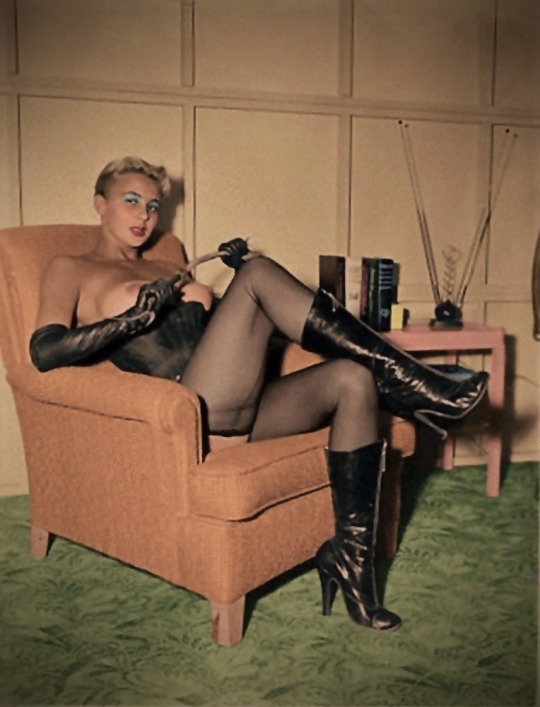
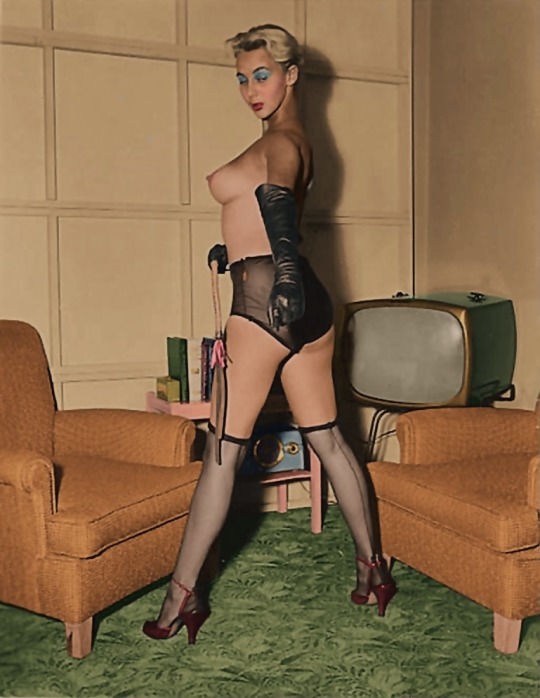
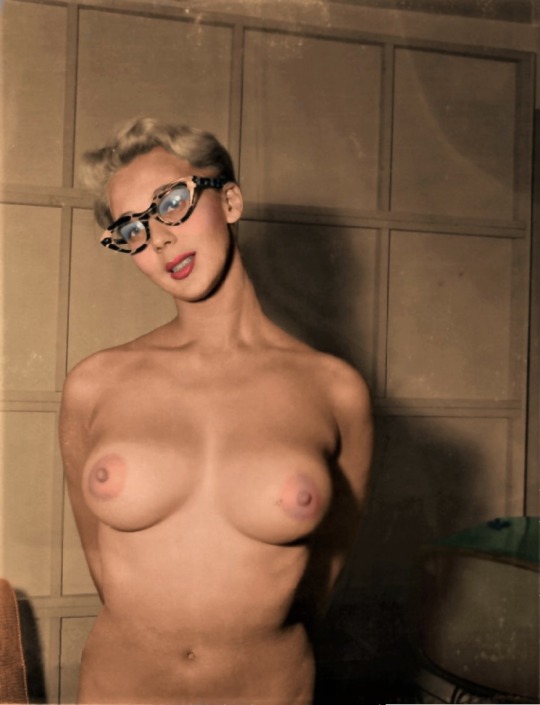

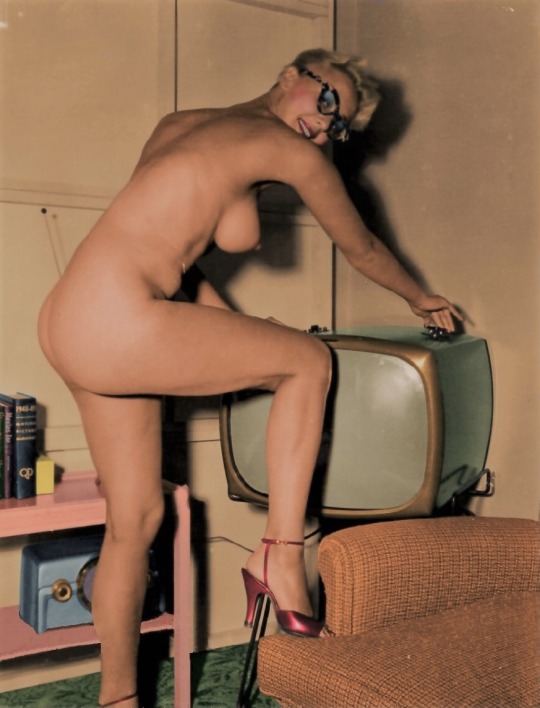
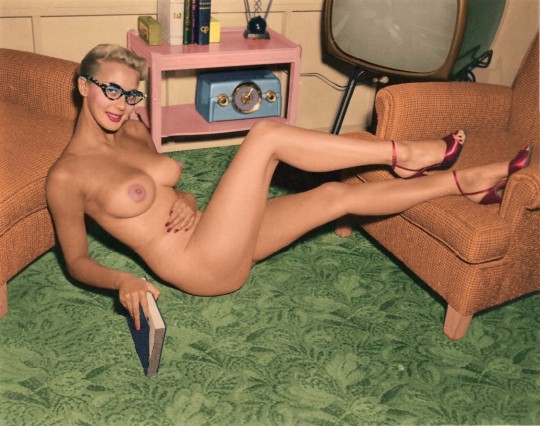

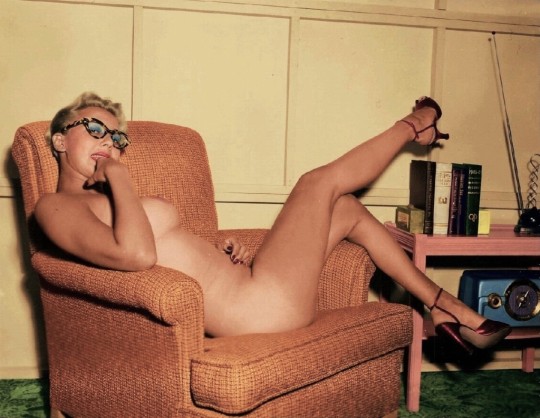

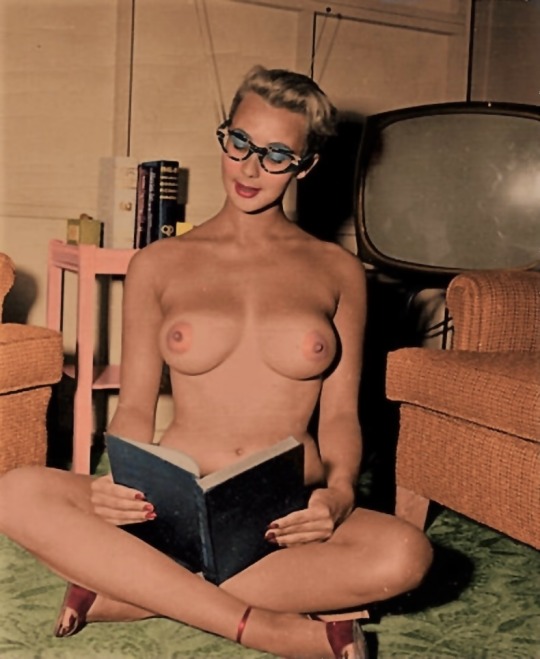
175 notes
·
View notes
Text
Inspiration & Precedents - Damien Hirst and Mark Jenkins
We worked in such an interesting manner. We’d ideate whilst simultaneously finding further inspiration on artists and knowledge on how to execute our visions. In this blog post i will be looking deeply into two very influential artists in regards to our project as well as a few artists that inspired me.
Artist 1: DAMIEN HIRST
youtube
As the video states “when artists make things in the 21st century, it’s open to interpretation” and “A work of Art is completed by the Viewer” Marcel Duchamp’s. I internalised this as art doesn’t have “to do what it says on the tin”. In other words, art is always open to interpretation.
As the artist it is our job to create a quality artefact, but how it is perceived is somewhat out of our control. I loved this most about his work. Hirst would create the striking pieces which -despite their simplicity- would captivate the viewer and evoke a range of emotions (mostly intrigue).
youtube
Our Take-away
Hirsts understanding of life and death was his key to creating artwork as “life is not about the thought of living but just to live so you can produce your own outcomes”. He specialised int he human body as well as other biological specimens and created models of their bodies to allow people to explore and come to their own understandings. This was the kickstarter to our project as it inspired us to explore the art of sculpture and exhibition.
Mark Jenkins tape sculptures
Mark Jenkins is a sculptor and installation artist whose work focuses greatly on urban & social themes, re-defining the limits of sculpture both in the public sphere and an art gallery setting.
“The foundation of his artwork is in the artist’s specific technique, casting objects as well as his own body (and those of others) using conventional packing tape and plastic wrap. Encompassing the actual form of these subjects with his method, he has materialised a range of characters, from translucent ducks, dogs and babies, to his most well-known clothed hyper-realistic figures”.
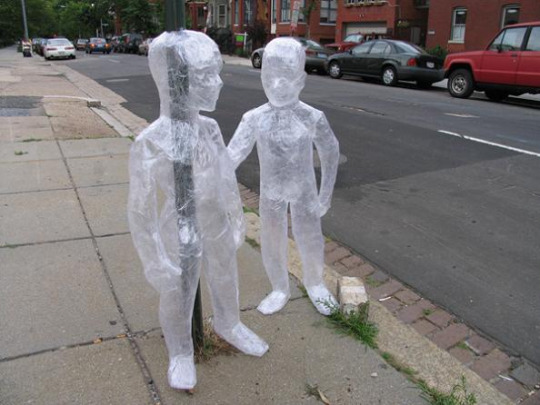
VITALS
Born: 1970 in Fairfax, Virginia
Education: Degree in Geology from Virginia Tech
Current Location: Washington DC

Mark Jenkins inspired me because through his art installations, to my understanding he crosses boundaries by re-defining the limits of what “immersion” can be. I believe his pieces invoke strong reactions from his unsuspecting audience and just like we intend to achieve, “the artist chooses to have the pieces speak for themselves”. As well as this, the artist operates skilfully in the tape medium we plan on using and he can therefore provide some insight into how he creates his sculptures, why he chose to work in that medium and how people react to his sculptures.
Artist inspo montage:
I have only highlighted two artists in this blog post, but this does not take away from the many artists we looked at and conducted research on when piecing together our final artefact. I will briefly highlight some of the things we took away from these artists.
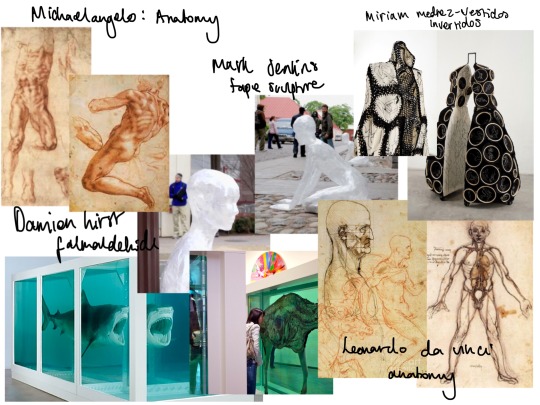
Miriam Medrez - Vestidos Invertidos: This artist really inspired us as she created some really beautiful fashion sculptures and displayed them in a ‘split’ manner that resembled those of Damien hirst. This taught us that the concept of splitting items in half was not limited to being only effective with shock factor (such as Damien hirsts’ formaldehyde sculptures). The artists use of fabrics, sculptural structures and threads were truly instrumental in inspiring us to incorporate fabrics also.
Leonardo Da Vinci & Michaelangelo
I Referenced to both these artists anatomy/body sketches in the initial ideas phase. Their drawing techniques really showed me how simple it was to draw the human form. These sketches could be achieved through form, depth and tones.
Video tutorials and tips
youtube
youtube
Videos, such as the two embedded above, really helped in showing us how to create our prototype body casts by demonstrating the techniques and materials needed to do so (more info can be found about how i applied this knowledge in my Experimenting blog post).
vimeo
This page also helped in the process https://www.instructables.com/How-to-Make-a-Human-Tape-Sculpture/
2 notes
·
View notes
Text
Plane Easy|| Miriam, Rebecca and Theodora
TIMING: Current
PARTIES: @meflemming, @slayed-slayer and @exorciseyourspirit
SUMMARY: Janet from The Good Place voice: Not a witch.
CONTENT: Blood, Possession Non-Con
Over the past few weeks, Rebecca had been gathering all the supplies and materials she would need to help her astral project while awake. She’d tried a few times, with little success, so she’d gone to the local magic store to try and get more information on it. A few new books on the subject had pointed her in the right direction. It told her that going to a place charged with emotion would help, as well as finding somewhere where the veil was thin. And she knew just the place. Theodora’s grave. She hadn’t visited still, the last time her body had been there it had not been her own, but it was now. It would be strange, she supposed, to be standing next to her wife’s grave with her floating nearby, but what choice did she have? She knew Theo would never let her do this, or come here, alone, so this was how it was to be.
When they arrived at the cemetery, Rebecca had made sure to check the perimeter, and Theo had even double checked her scouting. No one in sight, not even a spawn. The trek to the grave was slower, and the closer they got, the slower Rebecca went. Stopping almost completely even when she was still meters away from it. Swallowing, she looked where she thought Theodora might be judging by her feel, and went up to the grave, staring down at it. Theodora Fairfax, Loving Wife, Friend. July 16th, 1973 - September 27th, 2018. And below that, her quote: Tho’ much is taken, much abides; and tho’ We are not now that strength in which old days, Moved Earth and heaven, that which we are, we are.” Rebecca was still for a long moment, before opening up her pack and beginning to lay out all her stuff. Candles, incense, herbs, and the mat that she’d drawn her safety pentacle on. She didn’t look up as she worked, worried she’d see right through her wife again, as she sat next to her grave. “You remember the plan?” she asked quietly, smoothing down the mat.
“I do. Maintain a safe perimeter, and if anything seems amiss, stick you with your dagger until you wake. Nothing I can’t handle, even in death,” Theodora replied gently, hovering close to her ear. She sat down on her headstone and regarded her wife with as much care as worry. She was nervous, and with good reason. Rebecca’s soul had always been sensitive, astute, but she had never tried anything like this with her capabilities before. Seeing her nerves, Theodora couldn’t help but be concerned herself. She knew, of course, that Rebecca’s unflappable air was just that, that exhaustive amounts of care and study went into every ritual. And oh, this was not the time to rattle her with warnings and questions. They had gone over the details plenty of times at Rebecca’s home as it was. “You didn’t have to come do it here, dearest,” she said, “Though I do appreciate the gesture.”
Cemeteries were fine places for walks. Sure, ghosts could be a little chatty, and, sure, there were chances for Miriam to run into the nosier members of her own kind, not to mention the more primal ones, but it was relaxing. And, sometimes, it was even fun. Sometimes, you could just be walking, and you’d end up stumbling upon a little witch and a ghost hanging out on a tombstone, surrounded by all kinds of fun items. But it could just be some idiot poser without a clue. All kinds of people these days were into that New Age bullshit that Miriam had seen on television advertised late at night. Famous people made all sorts of money selling the bullshit, selling ideas of nonsense as real magic. This could just be nonsense. But, if it was real… Miriam could really go for a bit of pain and misery. Possibly even a full meal. Who knew? Keeping her distance, Miriam crouched not too far away, behind a large angel statue. She went completely still. If one weren’t paying attention, they’d simply think she was another monument to the dead. In a way, she kind of was.
“I truly wish it were under different circumstances,” Rebecca mumbled, sitting down next to the headstone. “Though I suppose I should...apologize for not coming any sooner. The book suggested somewhere of...value. So...” Theo was close to her, she could feel it, but it only made her heart wrench more, wishing she could see her. She glanced down at her arrangement and muttered a word, in her natural tongue, and the candles all lit. She smiled. “Been practicing that one,” she said, looking over at where she hoped Theo was. “Magic isn’t my forte, but small things are accomplishments, too.” She settled herself in and took up her meditation position. Legs crossed in front of her, hands resting palm up on her knees and open. Rebecca’s spirituality had always been an inherent part of her being, it was why she felt so compelled to help spirits, why she felt it her destiny to become an exorcist. Why she had the ability to astral project, and why she was here, now, meditating in a cemetery. If she could reach the other plane on her own, then, maybe, she could find a way to pull him out with her. It was a long shot, but it was one worth taking.
She gave one last exhale and nod-- “Here goes nothing”-- before closing her eyes and concentrating. Letting the energy of the world around her flow into the circle, pulling it in, calling it with her own spirit. It was a lot like an exorcism, in the way that she pushed through the energies around her to call to the right ones, but instead of compelling them away, she was pulling them in. The circle she sat upon began to glow, a soft hum of light engulfing her. Hair waving limply in the small wind that pooled inside of her sanctum circle. She reached through the ether, through the pull of magic, and searched for it-- the astral plane. Latched on, tugged. Rebecca’s body, once stiff, slumped.
Grinning like the cat that caught the canary, Miriam decided that she’d more than seen enough. Glowing circles were magic bull shit, sure, but the real kind of magic bull shit that she was brought back to destroy. Who the hell knew what the little witch was doing? Miriam resolved herself to end it before it even began. Eyes red and fangs out, she stalked close slowly, careful not to make a sound. Just as she drew close enough, Miriam leapt forward and onto the woman in the circle, knocking them both out of it and taking the woman to the ground. She could practically feel the magic radiating off of the woman. Or maybe she couldn’t; Miriam wasn’t sure what about her feelings towards magic were her own rage and which were legitimate. She’d been so sure that the old man she’d tailed home last week had been a spell caster, had practically felt the magic burning across her skin when he’d touched her in the grocery store, and he’d just turned out to be an old man. A creepy one, but an old human man with no magical abilities except for the unnatural octaves at which he could scream. But she knew this was real, this was different, and, as she leaned over the woman, fangs out and mouth twisted into a snarl, she knew she was going to take a real long time with this. She didn’t even pay attention to the little ghost hanging about.
Theodora saw the vampire coming. She leapt to her feet, instincts from her life firing at once. It wasn’t until her hand went through the dagger that she realised how helpless she was. She could grab it again, concentrate, be more than a bundle of impulses, but what good would that do against a creature already dead? “Get away from her!” She cried. “Rebecca!” She reached for the dagger anyway, what could she do but try? What slayer wouldn’t face a foe with at least some kind of weapon? She flung herself at the vampire, sinking the blade into her shoulder. “Let her go, let her go, damn you!” She cried. She twisted it, hoping in vain that at least the pain would be enough to deter her. She could not fail at this again. She wouldn’t. If she could just throttle her, if she could just make the creature’s hands her own and make her stop…
When Rebecca’s eyes opened again, she wasn’t in the cemetery. A fog rolled at her feet, so thick and heavy she couldn’t see them. The world around her was cold and dark, but she couldn’t feel anything. “Hello?” she called out tentatively. Her voice echoed everywhere. One step and her footsteps echoed everywhere. Had she done it? Was this the astral plane? It seemed so unfamiliar, so unlike where she’d been in her dreams, while he was awake. She needed to find a way, now, to peer back into the real world. To the Earthly plane, and make sure she hadn’t just given him free reign. But she somehow felt like she knew he wasn’t there. She didn’t feel the same, heavy tug as before. A sudden voice rang out, sounding far away. It barely reached her ears, but she knew who it was. “Theodora?” she called back. Was she talking to her or trying to wake her? Rebecca turned in circles. “Theodora?”
Back in the cemetery, Rebeecca’s body still lay limp, tousled under the pressure of Miriam’s body bearing down above her. Helpless.
Miriam felt the knife in her shoulder, but instead of reacting to the pain of it, she grinned widely, too focused on her quarry underneath her. In fact, it was quite useful for her. She looked at the little ghost raging against her. “Thanks for the gift, sweetness.” She plucked the knife out, not even wiping it free of dark, dead blood. She twirled it between her fingers, admiring it or a bit. A bit of a longer, thinner blade than she was used to, but it was a really nice blade. Miriam couldn’t complain. Perhaps she should even invest in more traditional styles of weaponry. Then again, skinning knives were kind of her specialty. But this one was so lovely. She ran it along the little witch’s collar bones, digging in deep enough for blood to bead up to the surface, enough to hurt. But there was no reaction underneath her, no flinch, no pain. Miriam snarled again at the lack of reaction, frustrated by it and the ghost’s annoying presence. “Go away,” she growled out before she stabbed the knife into the woman’s shoulder, hoping for a reaction. She twisted it in the same way the ghost had attempted to do to her.
Theodora reached for the knife again, crying out, “No!” But whatever pull she managed to work on the hilt, it was no match for the vampire’s strength. She screamed, furious and wild as an animal as the blade sank into Rebecca’s shoulder. She reached for the vampire as if to shove her off with force. Perhaps she even could. She only knew she could not let her hurt Rebecca, she would not take her wife from the earth, and if she had to make her…
The shift happened so swiftly, Theodora was still screaming when she found herself in the creature’s body. “Bloody hell,” she whispered, the vampire’s voice, her tongue and teeth feeling strange after two years without a body. She tested her hands, flexing her fingers. They obeyed her command just easily as her own once had. Of all the ways… But, there was more important work to be done. “Rebecca!” She called, reaching across for her bag. Rebecca was always prepared, there had to be something to staunch the bleeding. “Rebecca, can you hear me, darling? Wake up! Please, darling!”
“Theo--” Rebecca started. In the next moment, pain ripped through her. Ripped her from her spot, pulled her back down to Earth, back into her body, back where it stayed, loud and clear and jolting. Rebecca screamed, eyes shooting open. She saw someone unfamiliar above her, even through the blur of red, hot tears matching the searing pain in her shoulder. Let me help you came the voice in her ears again, just like during the exorcism. Rebecca struggled to move, thrashing under the weight of whoever this was, pain pouring up and down her arm, into her chest, her neck, her stomach. “Get off!” she shouted, shoving at her. “GET OFF!”
Theodora fell back easily, collapsing to the ground. “Rebecca don’t--!” She cried, putting out an arm towards her. “Don’t move, you’ll make it worse! Let me help, let me help this time.” Hearing the strange voice in her ear, seeing a bewildering streak of blonde hair in her eyes, she realized how her request this might seem. She hadn’t thought things out this far. “It’s me!” She said quickly. “It’s Theo, I’m--I’m Theo, darling. For now, at any rate. I--I know the song we danced to in my London flat was ‘heroes,’ and your birthday is coming soon, and, oh for heaven’s sake, will you just let me close?”
Let me help, I can help. Rebecca thrashed again, pain rippling down her body. “Lehizdayen, hashem!” she cursed, grabbing her shoulder where it burned, feeling wet cloth stick between her fingers, the scent of blood suddenly thick in her nostrils. Forced herself to sit up, shaking with the effort, the pain, the exhaustion of being ripped from the plane like that. Dizzy, she looked up. Locked eyes with the body in front of her. And she knew. Even without the words, she knew. She could see it in her eyes, feel it in the air. “Theo…?” she panted, struggling forward, collapsing into her. “Theo, it’s you. My love. You’re here. You’re really…”
Theodora couldn’t help but smile as recognition dawned on Rebecca’s features. “Yes,” she said, tears and laughter welling up at once as she crashed into her--crashed with relief and force that Theodora could feel because she had a body. “Yes, darling. I’m really here.” And seeing her wife in her arms, having their eyes meet, truly meet and know each other, she could think of nothing to do next but cup her face and kiss her as she had longed to do since she’d found she returned. It was strange, as far as kisses went. One wasn’t usually a stranger to their own lips. But Rebecca’s were familiar, as soft as all her memories, and Theodora couldn’t quell the longing or the pent up desire in her. It wasn’t until her arm brushed against the blade in Rebecca’s shoulder, irritating her wound, that she had the good sense to stop and pull back. “I think I’ve missed you too much,” she said. “I’m getting carried away. Let’s tend to your wounds quickly, yes?”
Rebecca’s heart swelled. It didn’t feel the same, her lips were too cold, too soft, but it was still Theo. She kissed her back, her Theo, her lover, who she thought she’d never get to see again, hold again, let alone kiss again, still dizzy and weary from the pain in her shoulder. Reality began to slowly trickle back in when she pulled away, her arm throbbing. She’d been stabbed with her own dagger, something sacred and ceremonial, and it was still dug deep into her skin, tearing muscle and sinew. “We can’t take it out,” she said, looking at it, her face already paling from the blood loss. “I need...hospital. And you need--” to get out of that body. But she couldn’t bring herself to say it. She wanted Theodora to say, she wanted her to have this forever, to be tangible and alive and real again forever. But she knew that wasn’t right, she knew that couldn’t happen. “To explain to me...what happened.” She panted again, drawing in a shaky breath. “Come, help me up. We can...take the car. It’s not far.”
Theodora knew what Rebecca meant. She had never possessed a body before, much less a vampire. There was no telling how long it would last, and of course, even if she hadn’t heard over and over from Rebecca over the years, she knew it was wrong. Even in a vampire, it was wrong. She squared her shoulders, straightened her back, and lifted Rebecca and her things with ease. “You shouldn’t be walking if you don’t have to,” she explained, stiffer now. They were working. They needed to move. “This—whoever she is, bloody vampire, came out from over there,” she gestured with her chin. “She was waiting for you to go into your trance, I think. Most likely thought it would be an easy snack. She moved quickly. There was only so much I could do, with the way I am. I’m still not sure how I managed to do this, exactly. But how far did you get? Did you see anything?” And perhaps, could she prattle on long enough to fill the silence? Enough to somehow prolong the moment, even as she marched them dutifully to its end?
It took more effort that Miriam would ever admit for her to take control of her body again. She hadn’t actually known she’d been fighting. She’d never been possessed before, despite her knowing that it’d be a possibility. It was an unnerving feeling, to come back to her head. She groaned a bit, stopping the walk that she’d been in the middle of, and took in her surroundings once more. There was the witch, standing and looking a bit worse for wear. Good, Miriam thought. The woman didn’t, for just the moment, seem to have noticed that Miriam was no longer her little ghostly companion. She stopped the other woman, not saying a word. Then, gently, so gently, she reached to the knife still in the witch’s shoulder. And she twisted it. Harshly. Gritting her teeth and growling animalistically, a small part of Miriam (the one that had long chats with nice witches on the internet and would prefer to drink fine wine than blood) was disgusted by her own behavior. However, a much bigger part was pissed off and hunger, and damn, this woman’s pain was so sweet. She yanked the knife out and grinned savagely. “Your move, bitch,” she said gutturally, head jerking around wildly looking for the ghost that possessed her.
“A vampire?” Rebecca exclaimed, a bit shocked in her own right. “You’re possessing a--” she paused, shook her head, trying not to think about the dagger buried in her shoulder. “Then why use my dagger?” She asked, unsuccessful. She shook her head, hobbling along beside her now that they’d grown closer to the car. “I think I did, it’s...all sort of fuzzy, still, but--” A chill ran through her for a moment. She stopped when Theodora did, looking over at her, just a little too late in her realization. The blade twisted and Rebecca cried out again, feeling more pain jolt through her, more blood as the metal was removed from her flesh and she teetered backwards, exhausted from her trip and now her apparent stabbing. She staggered away from her, heaving, hand pressed to the spot on her shoulder that was now leaking excessively. Fuck. “What do you want from me?” she hissed at her, realizing that her only line of defense was in the vampire’s hands, and Theodora was nowhere to be felt. That’s not all, and you know it, came the voice in her head, and her eyes flickered red just a moment. “Clearly you’re not just here for an easy meal,” she said, still struggling to stay standing, and to focus on the actual person in front of her when her vision was blurring into three different spaces.
“I want you dead, witch bitch,” Miriam snarled. “But I’ll take you in pain.” She bared her fangs. How dare this woman send a ghost to possess her. How’d she even manage that in the first place? She’d yet to meet a loyal ghost. Most of them just pined and bemoaned their inability to move on. They rarely went for any sort of action. And they certainly didn’t attack vampires. That was like possessing the hand that showed you attention. Well, see if Miriam stopped to chat with any one her way home. Fucking spirits. She ran her finger up the blade slowly, collecting blood onto her finger and licking it off. “This is an easy meal, darling. Your pain? You misery. My God, it’s absolutely delicious.” She slowly reached out and put her hand over the other woman’s, where it was covering the wound on her shoulder. Smiling pleasantly, she pressed down hard with the intent to cause pain. “This is fun. Aren’t you having fun, dearest?”
“Witch?” Rebecca repeated, raising a brow. “I’m not a--” but she didn’t have time to finish, as the vampire was closing in again, this time putting a hand over hers and pressing down. Rebecca recoiled in pain, clenching her jaw as to not let the hideous sound in her throat out. She didn’t want to give her any more satisfaction. Let me show you how it’s done, said the voice in her head. “No,” she hissed back, to both of them, backing away again, Stumbling into the brick wall behind her that lined the cemetery. “You stay away from me.” Red eyes flickering once again, hairs on her arms bristling, standing on end. The second the vampire moved towards her again, a wave of energy shot from her, knocking her back. Rebecca’s heaved, sliding down the wall to a sit, worn. Give me control. I can save us. “No,” she said again, looking over at the vampire with fierce eyes. “Theodora! I know you’re in there! Get your ass out here and help me!”
Theodora’s grip fell from the vampire’s body before she realized it was slipping. One moment she was setting Rebecca on the ground, the next it was dark. She didn’t know how to push, exactly, for control. Had she any means of scratching, even biting her way to power it would have been easy. But there was nothing, and damnit, who knew what she was doing to Rebecca now. Theodora concentrated on getting to the surface. It had been a trick of will before, hadn’t it? She had wanted the vampire to stop. Now was no different. And lest she get too comfortable, undead bitch, Theodora would drag her back down to her place. She was a slayer. Dead and disgraced for one reason or another, she was still a slayer. And she would not hand Rebecca over to any vampire’s clutches.
The next thing Theodora knew, the day was before her again. Her body (God help her, it had worked; she had a body) was on the asphalt, stinging from something. She looked wildly about her, rushing to get her bearings. Rebecca was slumped against the wall, bleeding worse than before. “Rebecca!” She rushed to her, but stopped just short of taking her into her arms again. “I can’t—I don’t know how long I can hold on. But I can get you to the car safely, at least.” She looked down, her face, however strange, riddled with apology, and tentatively held out her hand.
“No, just--” Rebecca started, wheezing now with the effort it took to breath and hold onto herself in spite of the pain. “Get her out of here. She’s a...witch….hunter…” she grunted through each word with each breath, straining to pull herself up. “I can get myself...to the hospital...just...meet me there.” Staggered towards the car, hand still pressed to the open and gushing wound, her arm having gone numb a long time ago, despite the pain coursing through her chest and into her shoulder and back out again. She looked back at Theodora-- or, well, the vampire-- one last time, grieving, again, for the loss she was about to endure. It hadn’t been the same, it could never be the same, but it had been something. And something was more than she’d had in years to look forward to. To know that she had something here for her. To know that, perhaps, there was a way to get back all the things she’d lost.
Theodora couldn’t leave without knowing Rebecca was safe inside the car. She dared not touch her injury, there was nothing she could to but make it worse, or tempt the vampire into coming back to use it against her, but what was next for them? She would run, and she would throw the vampire somewhere safe, preferably near a hunter or two, or where she might get lost in the woods until sunrise. And what then? “Wait!” She called. She reached through Rebecca’s open window for her face and pulled her into one last rough, rushed kiss. “I love you,” she said. “And I’m sorry. Get there safe, I’ll take care of the rest. She pressed her fingers into her skin, trying to memorize the softness of it, the warmth of it. Then she turned and broke off at a sprint in the opposite direction. The vampire was fighting her, somehow she could feel it, but she would get them far, too far for there to be any trouble before she let go.
Rebecca collapsed into the car and started the engine, doing her best to hold onto her consciousness. Let me, he said inside of her head, and before she could say no, her eyes closed and she fell back into unconsciousness.
The car started, and drove in the direction of the hospital.
Miriam was running when she came to, unsure of where she was. She skidded a bit to a stop, looking around wildly. No witch. No ghost. She screamed, grabbing her head. “Out, out, out,” she snarled, not knowing where the fuck the ghost was, if it was even still inside her. She was breathing heavy, not because she needed to but because the impulse was still there, even in her long dead body. She was panicked, just a little. She’d never been possessed, had no idea how to get unpossessed. The idea of losing control was devastating, and she could barely handle it. It was until she calmed down that she realized that she was alone inside her head. Or she hoped. It didn’t feel any more crowded than usual. She looked at her hands, one of them still clutching the knife. Miriam calmed herself a bit, taking in the beauty of the blade. It was still covered in blood. This was good, then. She liked souvenirs. This one just came a little earlier than usual.
13 notes
·
View notes
Text

Carole Lombard (born Jane Alice Peters; October 6, 1908 – January 16, 1942) was an American actress, particularly noted for her energetic, often off-beat roles in screwball comedies. She was the highest-paid star in Hollywood in the late 1930s and in 1999, the American Film Institute ranked Lombard 23rd on its list of the greatest female stars of Classic Hollywood Cinema.
Lombard was born into a wealthy family in Fort Wayne, Indiana, but was raised in Los Angeles by her single mother. At 12, she was recruited by director Allan Dwan and made her screen debut in A Perfect Crime (1921). Eager to become an actress, she signed a contract with the Fox Film Corporation at age 16, but mainly played bit parts. She was dropped by Fox just before her 18th birthday after a shattered windshield from a car accident left a scar on her face. Lombard appeared in fifteen short comedies for Mack Sennett between 1927 and 1929, and then began appearing in feature films such as High Voltage (1929) and The Racketeer (1929). After a successful appearance in The Arizona Kid (1930), she was signed to a contract with Paramount Pictures.
Paramount quickly began casting Lombard as a leading lady, primarily in drama films. Her profile increased when she married William Powell in 1931, but the couple divorced amicably after two years. A turning point in Lombard's career came when she starred in Howard Hawks's pioneering screwball comedy Twentieth Century (1934). The actress found her niche in this genre, and continued to appear in films such as Hands Across the Table (1935) (forming a popular partnership with Fred MacMurray), My Man Godfrey (1936), for which she was nominated for the Academy Award for Best Actress, and Nothing Sacred (1937). At this time, Lombard married "The King of Hollywood", Clark Gable, and the supercouple gained much attention from the media. Keen to win an Oscar, Lombard began to move towards more serious roles at the end of the decade. Unsuccessful in this aim, she returned to comedy in Alfred Hitchcock's Mr. & Mrs. Smith (1941) and Ernst Lubitsch's To Be or Not to Be (1942), her final film role.
Lombard's career was cut short when she died at the age of 33 aboard TWA Flight 3, which crashed on Mount Potosi, Nevada, while returning from a war bond tour. Today, she is remembered as one of the definitive actresses of the screwball comedy genre and American comedy, and icon of American cinema.
Lombard was born in Fort Wayne, Indiana, on October 6, 1908 at 704 Rockhill Street. Christened with the name Jane Alice Peters, she was the third child and only daughter of Frederick Christian Peters (1875–1935) and Elizabeth Jayne "Bessie" (Knight) Peters (1876–1942). Her two older brothers, to each of whom she was close, both growing up and in adulthood, were Frederick Charles (1902–1979) and John Stuart (1906–1956). Lombard's parents both descended from wealthy families and her early years were lived in comfort, with the biographer Robert Matzen calling it her "silver spoon period". The marriage between her parents was strained, however, and in October 1914, her mother took the children and moved to Los Angeles. Although the couple did not divorce, the separation was permanent. Her father's continued financial support allowed the family to live without worry, if not with the same affluence they had enjoyed in Indiana, and they settled into an apartment near Venice Boulevard in Los Angeles.
Described by her biographer Wes Gehring as "a free-spirited tomboy", the young Lombard was passionately involved in sports and enjoyed watching movies. At Virgil Junior High School, she participated in tennis, volleyball, and swimming, and won trophies for her achievements in athletics. At the age of 12, this hobby unexpectedly landed Lombard her first screen role. While playing baseball with friends, she caught the attention of the film director Allan Dwan, who later recalled seeing "a cute-looking little tomboy ... out there knocking the hell out of the other kids, playing better baseball than they were. And I needed someone of her type for this picture." With the encouragement of her mother, Lombard happily took a small role in the melodrama A Perfect Crime (1921). She was on set for two days, playing the sister of Monte Blue. Dwan later commented, "She ate it up".
A Perfect Crime was not widely distributed, but the brief experience spurred Lombard and her mother to look for more film work. The teenager attended several auditions, but none was successful.[11] While appearing as the queen of Fairfax High School's May Day Carnival at the age of 15, she was scouted by an employee of Charlie Chaplin and offered a screen test to appear in his film The Gold Rush (1925). Lombard was not given the role, but it raised Hollywood's awareness of the aspiring actress. Her test was seen by the Vitagraph Film Company, which expressed an interest in signing her to a contract. Although this did not materialize, the condition that she adopt a new first name ("Jane" was considered too dull) lasted with Lombard throughout her career. She selected the name "Carol" after a girl with whom she played tennis in middle school.
In October 1924, shortly after these disappointments, 16-year-old Lombard was signed to a contract with the Fox Film Corporation. How this came about is uncertain: in her lifetime, it was reported that a director for the studio scouted her at a dinner party, but more recent evidence suggests that Lombard's mother contacted Louella Parsons, the gossip columnist, who then got her a screen test. According to the biographer Larry Swindell, Lombard's beauty convinced Winfield Sheehan, head of the studio, to sign her to a $75-per-week contract. The teenager abandoned her schooling to embark on this new career. Fox was happy to use the name Carol, but unlike Vitagraph, disliked her surname. From this point, she became "Carol Lombard", the new name taken from a family friend.
The majority of Lombard's appearances with Fox were bit parts in low-budget Westerns and adventure films. She later commented on her dissatisfaction with these roles: "All I had to do was simper prettily at the hero and scream with terror when he battled with the villain." She fully enjoyed the other aspects of film work, however, such as photo shoots, costume fittings, and socializing with actors on the studio set. Lombard embraced the flapper lifestyle and became a regular at the Coconut Grove nightclub, where she won several Charleston dance competitions.
In March 1925, Fox gave Lombard a leading role in the drama Marriage in Transit, opposite Edmund Lowe. Her performance was well received, with a reviewer for Motion Picture News writing that she displayed "good poise and considerable charm." Despite this, the studio heads were unconvinced that Lombard was leading lady material, and her one-year contract was not renewed. Gehring has suggested that a facial scar she obtained in an automobile accident was a factor in this decision. Fearing that the scar—which ran across her cheek—would ruin her career, the 17-year-old had an early plastic surgery procedure to make it less visible. For the remainder of her career, Lombard learned to hide the mark with make-up and careful lighting.
After a year without work, Lombard obtained a screen test for the "King of Comedy" Mack Sennett. She was offered a contract, and although she initially had reservations about performing in slapstick comedies, the actress joined his company as one of the "Sennett Bathing Beauties". She appeared in 15 short films between September 1927 and March 1929, and greatly enjoyed her time at the studio. It gave Lombard her first experiences in comedy and provided valuable training for her future work in the genre. In 1940, she called her Sennett years "the turning point of [my] acting career."
Sennett's productions were distributed by Pathé Exchange, and the company began casting Lombard in feature films. She had prominent roles in Show Folks and Ned McCobb's Daughter (both 1928), where reviewers observed that she made a "good impression" and was "worth watching". The following year, Pathé elevated Lombard from a supporting player to a leading lady. Her success in Raoul Walsh's picture Me, Gangster (also 1928), opposite June Collyer and Don Terry on his film debut, finally eased the pressure her family had been putting on her to succeed. In Howard Higgin's High Voltage (1929), her first talking picture, she played a criminal in the custody of a deputy sheriff, both of whom are among bus passengers stranded in deep snow. Her next film, the comedy Big News (1929), cast her opposite Robert Armstrong and was a critical and commercial success. Lombard was reunited with Armstrong for the crime drama The Racketeer, released in late 1929. The review in Film Daily wrote, "Carol Lombard proves a real surprise, and does her best work to date. In fact, this is the first opportunity she has had to prove that she has the stuff to go over."
Lombard returned to Fox for a one-off role in the western The Arizona Kid (1930). It was a big release for the studio, starring the popular actor Warner Baxter, in which Lombard received third billing. Following the success of the film, Paramount Pictures recruited Lombard and signed her to a $350-per-week contract, gradually increasing to $3,500 per week by 1936. They cast her in the Buddy Rogers comedy Safety in Numbers (also 1930), and one critic observed of her work, "Lombard proves [to be] an ace comedienne." For her second assignment, Fast and Loose (also 1930) with Miriam Hopkins, Paramount mistakenly credited the actress as "Carole Lombard". She decided she liked this spelling and it became her permanent screen name.
Lombard appeared in five films released during 1931, beginning with the Frank Tuttle comedy It Pays to Advertise. Her next two films, Man of the World and Ladies Man, both featured William Powell, Paramount's top male star. Lombard had been a fan of the actor before they met, attracted to his good looks and debonair screen persona, and they were soon in a relationship. The differences between the pair have been noted by biographers: she was 22, carefree, and famously foul-mouthed, while he was 38, intellectual, and sophisticated. Despite their disparate personalities, Lombard married Powell on June 6, 1931, at her Beverly Hills home. Talking to the media, she argued for the benefits of "love between two people who are diametrically different", claiming that their relationship allowed for a "perfect see-saw love".
The marriage to Powell increased Lombard's fame, while she continued to please critics with her work in Up Pops the Devil and I Take this Woman (both 1931). In reviews for the latter film, which co-starred Gary Cooper, several critics predicted that Lombard was set to become a major star. She went on to appear in five films throughout 1932. No One Man and Sinners in the Sun were not successful, but Edward Buzzell's romantic picture Virtue was well received. After featuring in the drama No More Orchids, Lombard was cast as the wife of a con artist in No Man of Her Own. Her co-star for the picture was Clark Gable, who was rapidly becoming one of Hollywood's top stars. The film was a critical and commercial success, and Wes Gehring writes that it was "arguably Lombard's finest film appearance" to that point. It was the only picture that Gable and Lombard, future husband and wife, made together. There was no romantic interest at this time, however, as she recounted to Garson Kanin: "[we] did all kinds of hot love scenes ... and I never got any kind of tremble out of him at all".
In August 1933, Lombard and Powell divorced after 26 months of marriage, although they remained very good friends until the end of Lombard's life. At the time, she blamed it on their careers, but in a 1936 interview, she admitted that this "had little to do with the divorce. We were just two completely incompatible people". She appeared in five films that year, beginning with the drama From Hell to Heaven and continuing with Supernatural, her only horror vehicle. After a small role in The Eagle and the Hawk, a war film starring Fredric March and Cary Grant, she starred in two melodramas: Brief Moment, which critics enjoyed, and White Woman, where she was paired with Charles Laughton. “We would have married,” said Carole Lombard during her interview with magazine writer Sonia Lee for Movie Screen Magazine in 1934 about her relationship with Russ Columbo, the famous singer killed in a tragic accident whose movie and radio career she had been guiding.
The year 1934 marked a high point in Lombard's career. She began with Wesley Ruggles's musical drama Bolero, where George Raft and she showcased their dancing skills in an extravagantly staged performance to Maurice Ravel's "Boléro". Before filming began, she was offered the lead female role in It Happened One Night, but turned it down because of scheduling conflicts with this production Bolero was favorably received, while her next film, the musical comedy We're Not Dressing with Bing Crosby, was a box-office hit.
Lombard was then recruited by the director Howard Hawks, a second cousin, to star in his screwball comedy film Twentieth Century which proved a watershed in her career and made her a major star. Hawks had seen the actress inebriated at a party, where he found her to be "hilarious and uninhibited and just what the part needed", and she was cast opposite John Barrymore. In Twentieth Century, Lombard played an actress who is pursued by her former mentor, a flamboyant Broadway impresario. Hawks and Barrymore were unimpressed with her work in rehearsals, finding that she was "acting" too hard and giving a stiff performance. The director encouraged Lombard to relax, be herself, and act on her instincts. She responded well to this tutoring, and reviews for the film commented on her unexpectedly "fiery talent"—"a Lombard like no Lombard you've ever seen". The Los Angeles Times' critic felt that she was "entirely different" from her formerly cool, "calculated" persona, adding, "she vibrates with life and passion, abandon and diablerie".
The next films in which Lombard appeared were Henry Hathaway's Now and Forever (1934), featuring Gary Cooper and the new child star Shirley Temple, and Lady by Choice (1934), which was a critical and commercial success. The Gay Bride (1934) placed her opposite Chester Morris in a gangster comedy, but this outing was panned by critics. After reuniting with George Raft for another dance picture, Rumba (1935), Lombard was given the opportunity to repeat the screwball success of Twentieth Century. In Mitchell Leisen's Hands Across the Table (1935), she portrayed a manicurist in search of a rich husband, played by Fred MacMurray. Critics praised the film, and Photoplay's reviewer stated that Lombard had reaffirmed her talent for the genre. It is remembered as one of her best films, and the pairing of Lombard and MacMurray proved so successful that they made three more pictures together.
Lombard's first film of 1936 was Love Before Breakfast, described by Gehring as "The Taming of the Shrew, screwball style". In William K. Howard's The Princess Comes Across, her second comedy with MacMurray, she played a budding actress who wins a film contract by masquerading as a Swedish princess. The performance was considered a satire of Greta Garbo, and was widely praised by critics. Lombard's success continued as she was recruited by Universal Studios to star in the screwball comedy My Man Godfrey (1936). William Powell, who was playing the eponymous Godfrey, insisted on her being cast as the female lead; despite their divorce, the pair remained friendly and Powell felt she would be perfect in the role of Irene, a zany heiress who employs a "forgotten man" as the family butler. The film was directed by Gregory LaCava, who knew Lombard personally and advised that she draw on her "eccentric nature" for the role. She worked hard on the performance, particularly with finding the appropriate facial expressions for Irene. My Man Godfrey was released to great acclaim and was a box office hit. It received six nominations at the 9th Academy Awards, including Lombard for Best Actress. Biographers cite it as her finest performance, and Frederick Ott says it "clearly established [her] as a comedienne of the first rank."
By 1937, Lombard was one of Hollywood's most popular actresses, and also the highest-paid star in Hollywood following the deal which Myron Selznick negotiated with Paramount that brought her $450,000, more than five times the salary of the U.S. President. As her salary was widely reported in the press, Lombard stated that 80 percent of her earnings went in taxes, but that she was happy to help improve her country. The comments earned her much positive publicity, and President Franklin D. Roosevelt sent her a personal letter of thanks.
Her first release of the year was Leisen's Swing High, Swing Low, a third pairing with MacMurray. The film focused on a romance between two cabaret performers, and was a critical and commercial success. It had been primarily a drama, with occasional moments of comedy, but for her next project, Nothing Sacred, Lombard returned to the screwball genre. Producer David O. Selznick, impressed by her work in My Man Godfrey, was eager to make a comedy with the actress and hired Ben Hecht to write an original screenplay for her. Nothing Sacred, directed by William Wellman and co-starring Fredric March, satirized the journalism industry and "the gullible urban masses". Lombard portrayed a small-town girl who pretends to be dying and finds her story exploited by a New York reporter. Marking her only appearance in Technicolor, the film was highly praised and was one of Lombard's personal favorites.
Lombard continued with screwball comedies, next starring in what Swindell calls one of her "wackiest" films, True Confession (1937). She played a compulsive liar who wrongly confesses to murder. Lombard loved the script and was excited about the project, which reunited her with John Barrymore and was her final appearance with MacMurray. Her prediction that it "smacked of a surefire success" proved accurate, as critics responded positively and it was popular at the box office.
True Confession was the last film Lombard made on her Paramount contract, and she remained an independent performer for the rest of her career. Her next film was made at Warner Bros., where she played a famous actress in Mervyn LeRoy's Fools for Scandal (1938). The comedy met with scathing reviews and was a commercial failure, with Swindell calling it "one of the most horrendous flops of the thirties".
Fools for Scandal was the only film Lombard made in 1938. By this time, she was devoted to a relationship with Clark Gable. Four years after their teaming on No Man of Her Own, the pair had reunited at a Hollywood party and began a romance early in 1936. The media took great interest in their partnership and frequently questioned if they would wed. Gable was separated from his wife, Rhea Langham, but she did not want to grant him a divorce. As his relationship with Lombard became serious, Langham eventually agreed to a settlement worth half a million dollars. The divorce was finalized in March 1939, and Gable and Lombard eloped in Kingman, Arizona, on March 29. The couple, both lovers of the outdoors, bought a 20-acre ranch in Encino, California, where they kept barnyard animals and enjoyed hunting trips. Almost immediately, Lombard wanted to start a family, but her attempts failed; after two miscarriages and numerous trips to fertility specialists, she was unable to have children. In early 1938, Lombard officially joined the Baháʼí Faith, of which her mother had been a member since 1922.
While continuing with a slower work-rate, Lombard decided to move away from comedies and return to dramatic roles. She appeared in a second David O. Selznick production, Made for Each Other (1939), which paired her with James Stewart to play a couple facing domestic difficulties. Reviews for the film were highly positive, and praised Lombard's dramatic effort; financially, it was a disappointment. Lombard's next appearance came opposite Cary Grant in the John Cromwell romance In Name Only (1939), a credit she personally negotiated with RKO Radio Pictures upon hearing of the script and Grant's involvement. The role mirrored her recent experiences, as she played a woman in love with a married man whose wife refuses to divorce. She was paid $150,000 for the film, continuing her status as one of Hollywood's highest-paid actresses, and it was a moderate success.
Lombard was eager to win an Academy Award, and selected her next project—from several possible scripts—with the expectation that it would bring her the trophy. Vigil in the Night (1940), directed by George Stevens, featured Lombard as a nurse who faces a series of personal difficulties. Although the performance was praised, she did not get her nomination, as the sombre mood of the picture turned audiences away and box-office returns were poor. Despite the realization that she was best suited to comedies, Lombard completed one more drama: They Knew What They Wanted (1940), co-starring Charles Laughton, which was mildly successful.
Accepting that "my name doesn't sell tickets to serious pictures", Lombard returned to comedy for the first time in three years to film Mr. & Mrs. Smith (1941), about a couple who learns that their marriage is invalid, with Robert Montgomery. Lombard was influential in bringing Alfred Hitchcock, whom she knew through David O. Selznick, to direct one of his most atypical films. It was a commercial success, as audiences were happy with what Swindell calls "the belated happy news ... that Carole Lombard was a screwball once more."
It was nearly a year before Lombard committed to another film, as she focused instead on her home and marriage. Determined that her next film be "an unqualified smash hit", she was also careful in selecting a new project. Through her agent, Lombard heard of Ernst Lubitsch's upcoming film: To Be or Not to Be (1942), a dark comedy that satirized the Nazi takeover of Poland. The actress had long wanted to work with Lubitsch, her favorite comedy director, and felt that the material—although controversial—was a worthy subject. Lombard accepted the role of actress Maria Tura, despite it being a smaller part than she was used to, and was given top billing over the film's lead, Jack Benny. Filming took place in the fall of 1941, and was reportedly one of the happiest experiences of Lombard's career.
When the U.S. entered World War II at the end of 1941, Lombard traveled to her home state of Indiana for a war bond rally with her mother, Bess Peters, and Clark Gable's press agent, Otto Winkler. Lombard was able to raise over $2 million in defense bonds in a single evening. Her party had initially been scheduled to return to Los Angeles by train, but Lombard was anxious to reach home more quickly and wanted to fly by a scheduled airline. Her mother and Winkler were both afraid of flying and insisted they follow their original travel plans. Lombard suggested they flip a coin; they agreed and Lombard won the toss.
In the early morning hours of January 16, 1942, Lombard, her mother, and Winkler boarded a Transcontinental and Western Air Douglas DST (Douglas Sleeper Transport) aircraft to return to California. After refueling in Las Vegas, TWA Flight 3 took off at 7:07 p.m. and crashed into "Double Up Peak" near the 8,300-foot (2,530 m) level of Potosi Mountain, 32 statute miles (51 km) southwest of the Las Vegas airport. All 22 aboard, including Lombard, her mother, and 15 U.S. Army soldiers, were killed instantly. The cause of the crash was determined to be linked to the pilot and crew's inability to properly navigate over the mountains surrounding Las Vegas. As a precaution against the possibility of enemy Japanese bomber aircraft coming into American airspace from the Pacific, safety beacons used to direct night flights were turned off, leaving the pilot and crew of the TWA flight without visual warnings of the mountains in their flight path. The crash on the mountainside occurred three miles outside of Las Vegas.
Gable was flown to Las Vegas after learning of the tragedy to claim the bodies of his wife, mother-in-law, and Winkler, who aside from being his press agent, had been a close friend. Lombard's funeral was January 21 at Forest Lawn Memorial Park Cemetery in Glendale, California. She was interred beside her mother under the name of Carole Lombard Gable. Despite remarrying twice following her death, Gable chose to be interred beside Lombard when he died in 1960.
Lombard's final film, To Be or Not to Be, directed by Ernst Lubitsch and co-starring Jack Benny, a satire about Nazism and World War II, was in post-production at the time of her death. The film's producers decided to cut part of the film in which Lombard's character asks, "What can happen on a plane?" out of respect for the circumstances surrounding her death. When the film was released, it received mixed reviews, particularly about its controversial content, but Lombard's performance was hailed as the perfect send-off to one of 1930s Hollywood's most important stars.
At the time of her death, Lombard had been scheduled to star in the film They All Kissed the Bride; when production started, she was replaced by Joan Crawford. Crawford donated all of her salary for the film to the Red Cross, which had helped extensively in the recovery of bodies from the air crash. Shortly after Lombard's death, Gable, who was inconsolable and devastated by his loss, joined the United States Army Air Forces. Lombard had asked him to do that numerous times after the United States had entered World War II. After officer training, Gable headed a six-man motion picture unit attached to a B-17 bomb group in England to film aerial gunners in combat, flying five missions himself. In December 1943, the United States Maritime Commission announced that a Liberty ship named after Carole Lombard would be launched. Gable attended the launch of the SS Carole Lombard on January 15, 1944, the two-year anniversary of Lombard's record-breaking war bond drive. The ship was involved in rescuing hundreds of survivors from sunken ships in the Pacific and returning them to safety.
In 1962, Jill Winkler Rath, widow of publicist Otto Winkler, filed a $100,000 lawsuit against the $2,000,000 estate of Clark Gable in connection with Winkler's death in the plane crash with Carole Lombard. The suit was dismissed in Los Angeles Superior Court. Rath, in her action, claimed Gable promised to provide financial aid for her if she would not bring suit against the airline involved. Rath stated she later learned that Gable settled his claim against the airline for $10. He did so because he did not want to repeat his grief in court and subsequently provided her no financial aid in his will.
15 notes
·
View notes
Photo

Most Anticipated LGBTQIA+ Historical Romance Novels for 2019
Any Old Diamonds by KJ Charles
- In which we stick it to a duke. Any Old Diamonds is set in the late Victorian era and inspired by a number of things: a real historical crime (not telling you which, that would be a giveaway), the popular theatre of the time (hence the music-hall title), and my urge to find out what happened to some characters in my Sins of the Cities series, set twenty years earlier. I loved writing this one; I hope you enjoy a more-sociopathic-than usual hero.
How to Talk to Nice English Girls by Gretchen Evans (February 14 - @carnationbooks )(f/f)
- n the aftermath of The Great War, everything is changing. But not for Marian Fielding.Marian’s life is quiet and predictable in the solitude of the English countryside, where she plans to remain and care for her parents.But Marian’s world is turned upside down when she meets brash, confident Katherine Fuller. Katherine arrives at the Fieldings’ estate for the wedding of Marian’s sister and immediately shakes things up. Instead of keeping an eye on the ill-mannered American girl and keeping her out of trouble, Marian finds herself magnetically drawn to Katherine’s vivacious nature, and they are swept into a whirlwind romance that will change both of their lives.But will Katherine’s unconventional behavior ruin their chance at happiness? Can Marian leave her old life behind? Will two women from different worlds find a way to be together against all odds and expectations?
Royal Court (A Royal Romance Book Three) by Jenny Frame (January 14 - Bold Stroke Books)
- Captain Quincy is a steady and reliable Royal Marines officer, decorated for gallantry after a mission that nearly killed her and the men under her command. At a crossroads in her career, Quincy reluctantly accepts when her old comrade, Queen Georgina, asks her to join the Royal Protection Command as the Queen Consort’s new protection officer.
Holly Weaver, Royal Dresser and self-confessed man-eater, starts to question her sexuality when she has a girl-crush on famous actor, Story St. John and, then, polo player and friend of George’s, Captain Quincy.
The good-looking captain’s emotionless personality is the opposite of Holly’s exuberant lust for life. When a threat to the Queen Consort emerges, Quincy and Holly clash over the best way to protect her. As the fiery passion they can’t deny begins to melt Quincy’s heart, Holly must decide how much of her own she is willing to risk.
The Replacement Husband by Eliot Grayson (January 4 - Smoking Teacup Books)
- Goddess-blessed Owen Honeyfield is destined to enjoy perfect good fortune. The arrival of handsome and eligible Tom Drake in his country town appears to be the latest manifestation, and Tom’s whirlwind proposal is the fulfillment of Owen’s desires. When his betrothal takes a disastrous turn, Owen is left heartbroken and at the mercy of Arthur, Tom’s disapproving elder brother. His reputation ruined and his bright future shattered, Owen must choose between loneliness and a marriage of convenience, with love no longer in reach.
Arthur Drake has always taken responsibility for Tom’s scandalous behavior, but this time is worse — it isn’t just the family name at stake, but his own happiness. When Tom’s impulsive selfishness threatens to ruin the lives of everyone involved, Arthur has only one honorable choice. He’ll need to repair the damage Tom has done and fight for his chance at love, knowing all the while he may never be able to take Tom’s place in Owen’s heart.
Deosil (Whyborne & Griffin series) by Jordan L Hawk (Second half of 2019)
Hexhunter (Hexworld series) by Jordan L Hawk (February)
- Finally, Isaac and Bill’s story in this wonderful series. Watching them work around each other, and hoping they would have an installment, has been one of my major reading wants for awhile now.
A Place for Wolves by Kosoko Jackson (April 2 - Sourcefire Books)
- Aristotle and Dante Discover the Secrets of the Universe meets Code Name Verity in this heartbreaking and poignant historical thriller. (YA!!)
James Mills isn’t sure he can forgive his parents for dragging him away from his life, not to mention his best friend and sister, Anna. He’s never felt so alone.Enter Tomas. Falling for Tomas is unexpected, but sometimes the best things in life are.Then their world splits apart. A war that has been brewing finally bursts forward, filled with violence, pain, and cruelty. James and Tomas can only rely on each other as they decide how far they are willing to go—and who they are willing to become—in order to make it back to their families.
The Seventh of December by Garrick Jones (January 14 - Manifold Press)
- Even in wartime, London can still be glamorous, but for Tommy and his handsome American a secret mission for a Royal Duke puts life, love, freedom and the future of the world in desperate danger…
As bombs rain down over London during the Blitz, Major Tommy Haupner negotiates the rubble-filled streets of Bloomsbury on his way to perform at a socialite party. The explosive event of the evening is not his virtuosic violin playing, but the ‘almost-blond’ American who not only insults him, but then steals his heart.
The Seventh of December follows a few months in the lives of two Intelligence agents in the early part of World War Two. Set against the backdrop of war-torn occupied Europe, Tommy and his American lover, Henry Reiter, forge a committed relationship that is intertwined with intrigues that threaten the integrity of the British Royal Family and the stability of a Nation at war.
Neither bombs nor bullets manage to break the bond that these men form in their struggle against Nazism and the powers of evil.
Diplomatic Relations (Si Regency series) by JL Langley (February 19 - Dreamspinner Press)
- Opposites don’t just attract… they sizzle.A lusty special forces soldier who lives by his own set of rules, Dalton Fairfax decided long ago to stop wishing for his father’s love, and he found his calling. Now that he’s back home and between assignments, he finds himself at loose ends. When the opportunity arises to play bodyguard and help out his country, Dalton jumps at the chance. Not only does it keep him busy, but it just so happens that his charge is the man he saw on leave last month and hasn’t been able to get out of his head.Heir to a dukedom and a conservative politician, Blaise Thompson strives to prove himself worthy of carrying on the family legacy as the next IN Councilman. However, his closest competitor keeps getting in the way and taking credit for Blaise’s ideas. Maintaining his stellar reputation isn’t easy to do while keeping his outrageous younger brother in line and foiling his rival’s personal attacks. He has no time for a guard and even less time for romance.When a priceless antique goes missing, Blaise and Dalton discover that Regelance has larger problems than just IN plots. Now the only way to stop a scandal that threatens both of them is to compromise, and they are forced to confront the risk of losing everything… even each other.
Slay Ride by Josh Lanyon (February)
- 1943 Montana. Wounded in the Pacific, Police Chief Robert Garrett was hoping for a little much needed Peace on Earth, but finds himself chasing after a “fiendish” killer on Christmas Day–aided by eager young reporter Jamie Jameson.
Nomad’s Dreams by August Li (January 29 - Dreamspinner Press)
- Two men, each with a hidden destiny. Can they defeat a web of deceit and dark magic to ensure their fates intertwine?Bedouin Isra al-Grayjaab’s dreams lead him to Janan, an amnesiac beggar on the street of Qena—one who steals his heart and starts him on a seemingly hopeless quest. With only their wits, Isra’s knowledge of the desert’s secrets, and the aid of a mercurial djinn, they must recover Janan’s past. But neither can predict his true identity or the lengths others will go to see that his mind remains broken and his true power out of his reach.In a sweeping romantic adventure that takes them across the Eastern Desert to the modern streets of Cairo and on to the luxurious Red Sea Coast, Janan and Isra seek a truth that will either bring them into each other’s arms or tear them apart forever.
An Impossible Distance to Fall by Miriam McNamara (June 4 - Sky Pony)(YA!)(f/f)
- When the stock market crashed in 1929, it took Birdie’s whole life with it. A year later, she’s still struggling with the collapse of her father’s bank and his subsequent disappearance, and she’s determined to find him. She finally gets a clue when she sees a picture of the Jenny biplane that vanished with him on a leaflet advertising a barnstorming circus. She heads to Coney Island to get some answers, and promptly falls in love with the majestic spectacle of it all, from stuntmen to lady pilots, and especially with pilot June. When signs point to her father having moved on to Chicago, Birdie decides to hitch a ride with the circus. But while the circus folk might be the best thing that’s ever happened to her, a privileged girl who doesn’t understand how things work in the real world might be the worst thing that’s ever happened to them.
Moonwitch by MJ Willow (January 30 - @lessthanthreepress )
_ When several soldiers are attacked by wolves in the Duchy of Kamare, Prince Athanes travels north to solve the mystery. But the more he learns of the attacks, the more he realizes there is far more at play than hungry, desperate animals looking for food. He finds an unexpected ally in Faelan, a local hunter, but even he seems to have his own secret agenda…
A Shimmer In The Night (Dark Is The Night 2.5) by Kelley York and Rowan Altwood (January 1 - x-potion designs)
- Benjamin Prichard has spent much of his life feeling like an outsider. Growing up, his odd behaviour and visions of ghosts left him isolated, not to mention being the child of an immigrant mother and an absent father. Benjamin walks the line between not being Chinese enough for one community, and not English enough for the other.
Whisperwood School for Boys changes everything. More specifically, Preston Alexander does. Drawn into a close circle of friends for the first time, Benjamin finally feels as though he’s found somewhere he belongs. But life is never simple; his feelings for Preston are hardly platonic, and Benjamin doesn’t need one more reason to stand out—which means the option of pursuing those feelings is off the table.
But after graduation, when tragedy flips his world upside-down, Benjamin will need to decide which path he wants to chase: the one his mother always wanted for him, or the one that follows the boy he loves.
Ones to Watch (Up and coming authors I follow on Twitter that are winning awards in their own regions, some published, but I would like to see more of their work!)
Isabelle Adler - working on an arranged marriage, fantasy plot to be published by Nine Star Press - Frost?
Tamara Allen - has published some lovely works, and now that she has recently released something new, I’m hoping she has something else for us in 2019
Cristina Bruni - published the charming Hearts at Sea from JMS Books, and I like her work with the sweet plot line
Blake Ferre - working on a series based in Revolutionary France - The Scarlet Crest - The King’s Secret
Drew Marvin Frayne - his The Bibliophile novel was one that should have been on my Best of 2018 list, but I wasn’t able to read it in time - a sweet May/December with a western them, but it also tackled the subject of US government’s mistreatment of Native Americans and the consequences it caused
Jude Lucens - author of Behind These Doors, one of absolute favorite novels of 2018, and indeed many years before it - must see a second full novel in the series
Aleksandr Voinov - writes so many beautiful stories, but hoping for a new historical this year; his talent shines with the details
Lee Welch - received a lot of acclaim for Salt Magic, Skin Magic, and though I am not a rabid reader of fantasy, I want more…
44 notes
·
View notes
Note
What are your plans for Miriam? I'm just a CURIOUS passerby
I have none! ABAH i said before I had big plans for her, and if I did, I’ve completely forgotten them! Right now... Miriam has a girlfriend (who I have to make or if someone wants to ship ;;;))) ), she rides her skateboard on Fairfax where she spends all the money she makes from dealing, and nannying for a family! And proceeds to buy Supreme shirts that she wears so much that she destroys them :)
2 notes
·
View notes
Text

Miriam Fairfax
#miriam fairfax#pinup#vintage cheesecake#50’s pinup#vintage smut#60’s pinup#mid century modern#mid century pinup
578 notes
·
View notes
Text
Name: Amalthea
Alias: Maiden Warrior
Species: human
Gender: Female
Sexual Preference: Homosexuality
Age: 14
Birthdate: 4/20/1980
Birthplace: Academia
Alignment: Hood
Affiliation: Neutral good
Occupation: Warrior Princess
Figure: curve
Height: 7”0”
Weight: “6.7
Skin tone: Pale Peach
Hair: Black
Eyes: Black
Distinguishing Features: apple
Personality: smart kind courageous caring brave punctual
Dress: black turtleneck mini skirt,silver armor pink dress,puffy white semi sleeve,black fingerless gloves
Special items: Pendant
Weapons: sword and shield
Proficiencies:none
Magic/Special Abilities: flame slash,miracle slash,lighting storm, falcon slash,metal slash,dragon slash
Strengths:taking care of people
Weaknesses: being pushed away
Backstory:
Childhood:4
Adolescence:20
Adulthood:29
Relationships:
Parents:Queen Miriam and King Joseph
Siblings:none
Children:Ikki,Ran, and Dia
Relatives:Rikku
Partner:Yolanda
Familiar:none
Mentors:Ezra Scarlet
Friends:Rikku,Erza,and Yolanda
Allies:Yume Matsuda ,Ash Ketchum
Rivals:Ceylan Palman,Archemides Fairfax
Enemies:Saiyans and Titans,Saiyan King Lucifer
Pets: Oatmeal the ocelot
Likes:Camping,Tea,and seafood
Dislikes:Elephants,slimes and being like her parents
0 notes
Text
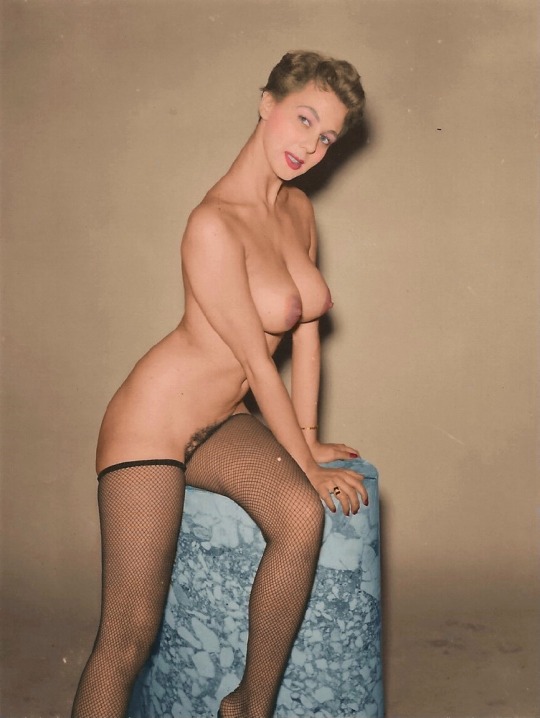
123 notes
·
View notes
Text

Miriam Fairfax aka Terri Burton - 1950s Era American Classic Men's Magazine Model.
#miriam fairfax#terri burton#1950s#classic men's magazine model#rear view#posterior#risque#raised arms#beautiful#favorite#magnificent#aiohotzgirl#magnificent breasts
72 notes
·
View notes
Photo
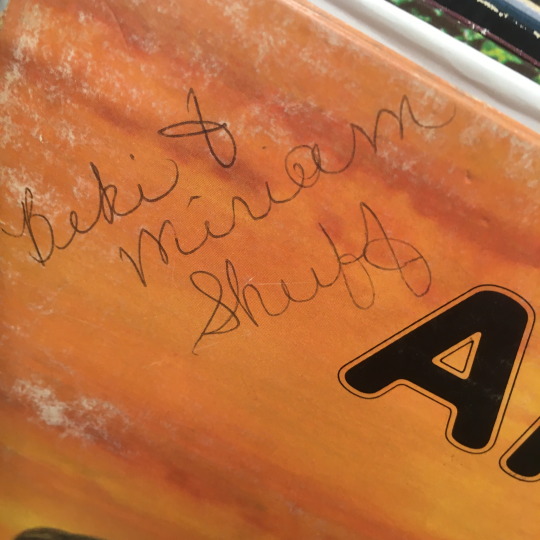
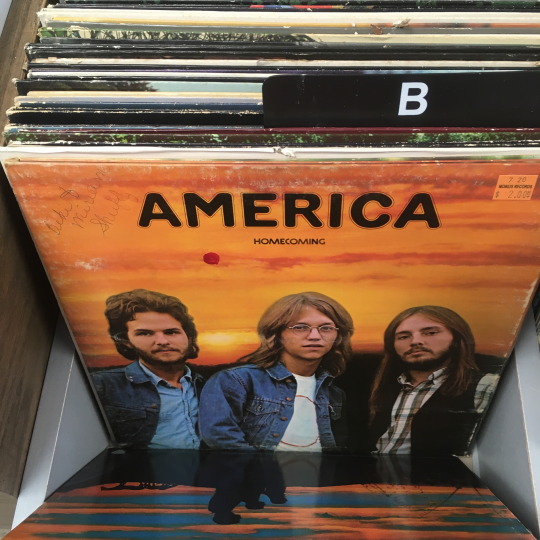
I found this in the bargain bin. A little research indicates that Beki Shuff may have lived in Clinton, Maryland, with her sister Miriam “Mim” Shuff.
Beki and Mim, if you are looking for your old record then give Mobius Records in Fairfax, Virginia, a call!
0 notes
Photo


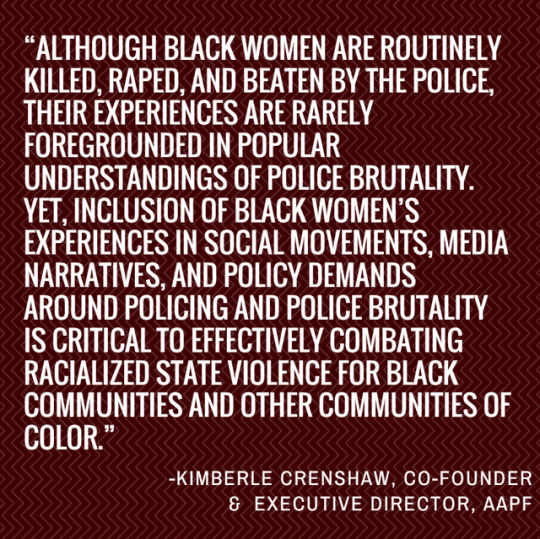

#SayHerName
AAPF - African American Policy Forum
http://www.aapf.org/sayhername
AAPF launched the #SayHerName campaign for Black women and girls who were killed by police and other forms of violence.
Fill The Void. Lift Your Voice.
Say Her Name.
-
#SayHerName: How Transgender Women Are Memorialized Online
Centered on feminism & women of the African Diaspora
https://www.blackfeminisms.com/transgender
The Transgender Day of Remembrance (TDOR) was started by transgender advocate Gwendolyn Ann Smith as a vigil to honor the memory of Rita Hester, a transgender woman who was killed in 1998. The vigil commemorated all the transgender people lost to violence that year and began an important memorial that has become the annual Transgender Day of Remembrance
“Citizen participation in the media, or contribution of user generated content or ‘citizen journalism’ as it’s commonly known is a growing phenomenon in some ways. Its benefits are that audiences witnessing incidents can post eyewitness accounts on the Internet as soon as they happen or send a report and photos to the media. Citizen journalism also dwells a lot on analysis and debate of issues and stories appearing in mainstream media. Unlike journalists in the mainstream media, citizen journalists can be anonymous contributors with no journalism training.”
-
Black Lives Matter | Say Her Name
http://sayhername.blacklivesmatter.com
Use #SayHerName to honor women and femmes who have been taken from us by state or intimate partner violence.
As part of the national #SayHerName day of action, we are asking folks to participate in lifting up women and femmes who are no longer with us, and/or those who inspire us in our everyday lives. Upload an image, graphic or photograph of someone you want to lift up, using either #SayHerName for those who have been taken from us and #InHerHonor for those who are still with us or passed from natural causes.
#SayHerName
Use #SayHerName to honor women and femmes who have been taken from us by state or intimate partner violence
#InHerHonor
Use #InHerHonor to lift up women and femmes in our everyday lives who are fighting and thriving in the face of adversity or who died from natural causes.
-
#SayHerName
AAPF - African American Policy Forum
It is for these Black women and girls that the African American Policy Forum launched the #SayHerName campaign. On May 20th, 2015, the African American Policy Forum, the Center for Intersectionality and Social Policy Studies at Columbia Law School, and over twenty local sponsoring organizations hosted #SayHerName: A Vigil in Memory of Black Women and Girls Killed by the Police at Union Square in New York City. Family members of Black women killed by police from across the country came together for the first time in a powerful vigil designed to uplift their loved ones' stories. The family members of Alberta Spruill, Rekia Boyd, Shantel Davis, Shelley Frey, Kayla Moore, Kyam Livingston, Miriam Carey, Michelle Cusseaux, and Tanisha Anderson were present and supported by hundreds of attendees, activists, and stakeholders.
-
The work of #SayHerName continues. Including Black women and girls in this discourse sends the powerful message that indeed all Black lives matter. If our collective outrage around cases of police violence is meant to serve as a warning to the state that its agents cannot kill without consequence, our silence around the cases of Black women and girls sends the message that certain deaths do not merit repercussions. Please join us in our efforts to advance a gender-inclusive narrative in the movement for Black lives.
-
In an effort to continue to call attention to violence against Black women in the U.S., the African American Policy Forum, the Center for Intersectionality and Social Policy Studies at Columbia Law School, and Andrea Ritchie, Soros Justice Fellow and expert on policing of women and LGBT people of color, issued in May 2015 a brief entitled “Say Her Name: Resisting Police Brutality Against Black Women.”
Say Her Name documents stories of Black women who have been killed by police, shining a spotlight on forms of police brutality often experienced disproportionately by women of color. In addition to stories of Black women who have been killed by police and who have experienced gender-specific forms of police violence, Say Her Name provides some analytical frames for understanding their experiences and broadens dominant conceptions of who experiences state violence and what it looks like. The brief concludes with recommendations for engaging communities in conversation and advocacy around Black women’s experiences of police violence, considering race and gender in policy initiatives to combat state violence, and adopting policies to end sexual abuse and harassment by police officers.
-
Black women are outnumbered by White women 5:1 in the United States, yet are killed by police in nearly the same numbers.
On August 1st, Korryn Gaines became one of those women. Shot and killed after an hours long standoff with Baltimore County police, Gaines became the ninth Black woman killed by police in just the first eight months of 2016. Jessica Williams, whose death garnered little media attention despite forcing SFPD chief, Greg Suhr, to resign, was shot while driving a presumed stolen car. She was unarmed and seems to have been fleeing from the officer when she was killed, yet she was still declared a threat to the officer’s safety, legally justifying her death. Similarly, police killed Kisha Michael, “a great mother” of three, even though she posed no obvious threat. Michael was found sitting in a car unconscious at an intersection in Inglewood CA. After allegedly failing to revive her and finding a gun, the LAPD retreated behind cover and fired several rounds into the car, killing Michael and a man who was with her.
Gynnya McMillen died alone in a Kentucky detention center cell. Formally, declared a tragic accident resulting from a rare, and undiscovered, heart condition, McMillen, only 16, was found dead after just one night at the Lincoln Village Juvenile Detention Center. However, in that one night she was tackled and pinned for over four minutes after she refused to take off her sweatshirt during a search. She was also placed in a cell alone and then largely forgotten about despite being notably unresponsive, a strong warning sign that something was not right. In the morning, Gynnya McMillen lay dead. It is frighteningly unclear whether anyone will face charges for the deaths of these women and the five others killed, but what is clear is that, particularly when compared to their male counterparts, little is known or said about stories and lives of these women.
This is nothing new. In 2015 alone, at least six Black women were killed by or after encounters with police.
Just before Freddie Gray’s case grabbed national attention, police killed unarmed Mya Hall—a Black transgender woman—on the outskirts of Baltimore. Alleged to be driving a stolen car, Hall took a wrong turn onto NSA property and was shot to death by officers after the car crashed into the security gate and a police cruiser. No action has been taken to date with respect to the officers responsible for her death. In April, police fatally shot Alexia Christian while she was being handcuffed in the back of a police cruiser. And in March in Ventura, California, police officers shot and killed Meagan Hockaday—a young mother of three—within 20 seconds of entering her home in response to a domestic disturbance.
Sandra Bland, the 28-year old Black woman from Naperville, Illinois who was arrested for allegedly assaulting a police officer during a traffic stop in Waller County, Texas on July 10 and was found dead in a jail cell three days later, is yet another victim of police brutality against African American women. And the six officers who swarmed and tasered Natasha McKenna to death in a Fairfax County Jail will face no criminal charges for their actions.
-
#SayHerName: How Transgender Women Are Memorialized Online
Transgender people, in particular transgender women of color, become targets of violence due to stigma about non-binary gender identities.
Mainstream media generally fails to bring attention to this violence. Social media, however, has been a significant platform for uplifting and memorializing transgender people who lose their lives.
For instance, when I looked at hashtags associated with #SayHerName between late January and October, I found that at least 21 transgender women named in corresponding hashtags. The majority of these women were victims of homicide. One had died in police custody and another was missing.
Yet, when I went to correspond the name of victims with news accounts, I most often found that independent media or bloggers were the only ones to report on this violence. This suggests to me that citizen journalism2 is particularly significant in highlighting violence against transgender women of color.
Most of these independent media and bloggers were platforms meant to uplift women of color, Black women in particular. For instance, BlackGirlTragic.Com consistently provided information not only about Black women who lost their lives to violence but also girls and non-Black women of color. Furthermore, they bring attention to violence that women face throughout the Diaspora, rather than the United States alone.
BlackGirlTragic.com exemplifies these platforms in that they are intentional about their mission to uplift Black women:
This site arose from a need to disrupt the traditional 24/7 news cycle, which focuses on one crisis and moves to another. Our goal at Black Girl Tragic is to highlight the discrimination, abuse, mistreatment, unfairness and tragedy inflicted upon women of color throughout the diaspora. 3
Black women use social media to act as citizen journalists, subverting the barriers of traditional institutions of media and journalism through the use of digital technology. Transgender Black women, then, are memorialized as a labor of love by Black women who see themselves as capable of making change by taking their message to the digital sphere.
0 notes
Text
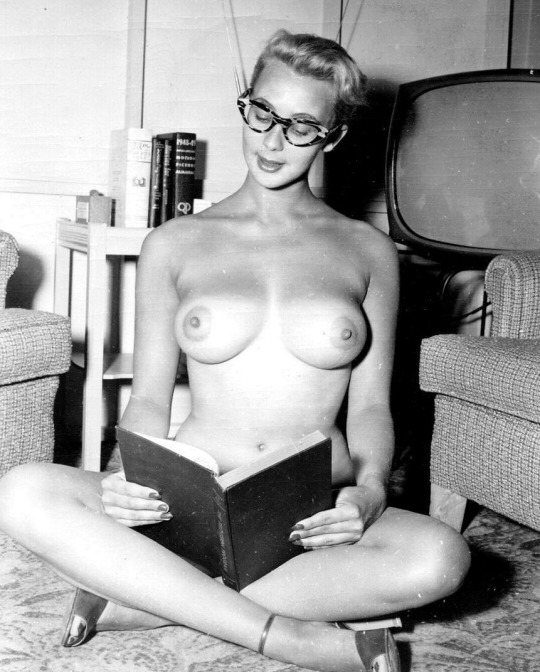
Miriam Fairfax, aka Terri Burton
780 notes
·
View notes
Text

79 notes
·
View notes